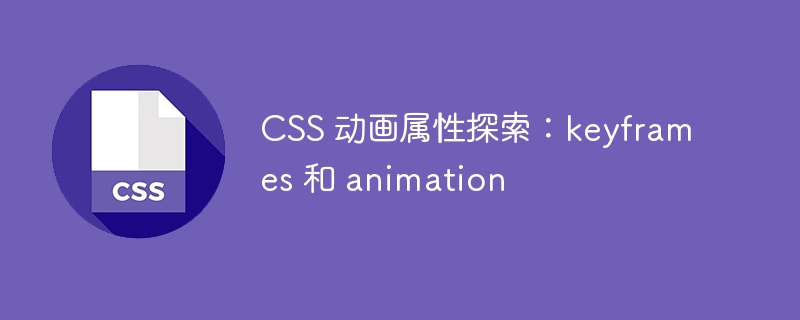

Exploration of CSS animation properties: keyframes and animation
Introduction:
CSS animation has become an important part of modern web design. It can add vivid interactive effects to web pages and improve user experience. In CSS, we can use the two properties keyframes and animation to create a variety of cool animation effects. This article will take you through an in-depth exploration of these two properties and provide specific code examples.
1. What are keyframes?
In CSS, keyframes are keywords used to define animation keyframes. We can use the " @keyframes " rule to define an animation sequence. The specific syntax is as follows:
@keyframes animation_name { 0% { /* 前景样式 */ } 50% { /* 中间样式 */ } 100% { /* 结束样式 */ } }
In this example, animation_name is the name of the animation, and 0%, 50%, and 100% are the key frames of the animation. Within each keyframe, we can define how the element will be styled during the animation.
2. What is animation?
animation is an attribute used to specify the animation applied to the element. We can apply defined keyframes to elements using the " animation " property. The specific syntax is as follows:
animation: animation_name duration timing_function delay iteration_count direction fill_mode play_state;
In this example, animation_name is the name of the animation we defined, duration is the duration of the animation, timing_function is the easing function of the animation, delay is the delay time of the animation, iteration_count is the animation The number of repetitions, direction is the playback direction of the animation, fill_mode is the fill mode of the animation, and play_state is the playback state of the animation.
3. Specific code examples:
Let’s look at a few specific code examples to help you better understand the use of keyframes and animation.
Gradient background animation:
HTML:
CSS:
@keyframes gradient { 0% { background-color: red; } 50% { background-color: blue; } 100% { background-color: green; } } .box { width: 200px; height: 200px; animation: gradient 5s linear infinite; }
In this example, we define a gradient background animation. The box element loops a gradient animation from red to blue to green over 5 seconds.
Element movement animation:
HTML:
CSS:
@keyframes move { 0% { transform: translateX(0%); } 50% { transform: translateX(50%); } 100% { transform: translateX(100%); } } .box { width: 100px; height: 100px; background-color: red; animation: move 3s ease-in-out infinite alternate; }
In this example, we define an element movement animation. The box element will loop and play a movement animation from the initial position to the right 50% position to the right 100% position within 3 seconds, and back and forth.
Blinking text animation:
HTML:
Hello, World!
CSS:
@keyframes blink { 0% { opacity: 1; } 50% { opacity: 0; } 100% { opacity: 1; } } .box { animation: blink 1s steps(1) infinite; }
In this example, we define a blinking text animation. The box element's text content will cycle through a flickering effect from fully opaque to fully transparent to fully opaque within 1 second.
Conclusion:
Through an in-depth exploration of keyframes and animation, we can find that they have great potential in creating a variety of cool animation effects. By reasonably combining various attributes, we can create rich and diverse animation effects and improve the interactive experience of web pages. I hope the content of this article can help you better understand and apply these two properties.
The above is the detailed content of Exploring CSS animation properties: keyframes and animation. For more information, please follow other related articles on the PHP Chinese website!




